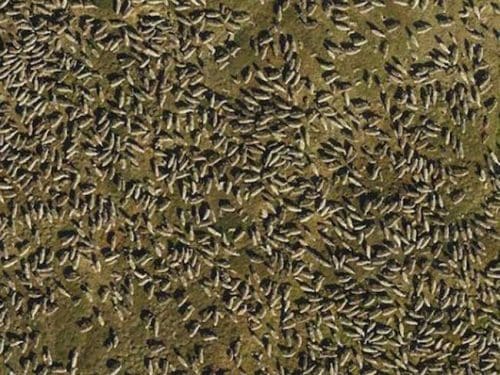The International Porcupine Caribou Board, including members from Canada and the U.S., met April 18-19 in Fairbanks. The event included an evening public meeting on April 18 at the Morris Thompson Cultural Center, where the Board presented its history and mission and engaged in a question-and-answer session.
The board had been inactive for over a decade until meeting in Whitehorse, Yukon Territory, Canada in September, 2011, where the Board reviewed its roles and responsibilities and the role of the Porcupine Caribou Technical Committee of biologists, who provide advice to the Board.
The Porcupine Caribou Herd is the 5th largest herd of migratory caribou in North America. It roams over approximately 180,000 square miles of Northern Alaska, Yukon, and Northwest Territories. The herd derives its name from the Porcupine River, which runs through a large part of its range. The herd’s 170,000 animals migrate some 1,500 miles annually between their winter range and calving grounds, the longest known land migration route of any mammal on earth. These caribou are the primary subsistence resource of the G’wich’in Alaska Native people, who traditionally built their communities based upon the caribou’s migration patterns. The animals are also routinely hunted by other Native peoples, including the Inupiat, Inuvialuit, Hän, and Northern Tutchone.
The Board was created through the Agreement Between the Government of Canada and the Government of the United States of America on the Conservation of the Porcupine Caribou Herd signed in 1987, and first met in 1989. The Agreement describes how the two countries will collaborate, noting that they will ensure “…that the Porcupine Caribou Herd, its habitat and the interests of users of Porcupine Caribou are given effective consideration in evaluating proposed activities within the range of the Herd.” and “Where an activity in one country is determined to be likely to cause significant long-term adverse impact on the Porcupine Caribou Herd or its habitat, the other Party will be notified and given an opportunity to consult prior to final decision.” While advice and recommendations of the Board are not binding on the Parties, by virtue of the Agreement the parties will consider the advice and respond to the recommendations of the Board.
The Board includes four members from Canada and four from the U.S. Canadian members are from the Canadian Wildlife Service of Environment Canada (for the Government of Canada), Yukon Department of Environment, Northwest Territories Department of Environment and Natural Resources, and the Porcupine Caribou Management Board. The U.S. is represented by Geoffrey Haskett, Alaska Regional Director, U.S. Fish and Wildlife Service; Craig Fleener, Deputy Commissioner, Alaska Department of Fish and Game; and Inupiat (Edward Rexford) and Alaska G’wich’in (Edward Frank) Villages.
At the April 18-19 meeting, Board members reviewed a draft communications strategy that included involving local communities and other stakeholders, compared harvest management plans in Alaska and Canada, heard an update on the Arctic Refuge Comprehensive Conservation Plan, and identified potential developments that may impact the Porcupine Caribou Herd.
According to Geoff Haskett, Alaska Regional Director of the U.S. Fish and Wildlife Service and Board Co-chair, the April meeting gave Board members a much clearer perspective on their challenges and opportunities.
“I was impressed by the positive interactions of our two delegations,” Haskett noted. “It’s gratifying to see two countries come together over something as valuable as the Porcupine caribou herd.” He noted that 85 percent of the Porcupine caribou harvest occurs in Canada, so that Nation has had to develop more responsive protocols and procedures for caribou management than has Alaska, where the herd’s inaccessibility has so far freed it from excessive hunting or development pressures.
Ms. Wendy Nixon, Canadian Co-chair of the Board also saw this second meeting as an opportunity to revitalize the Board, which had been inactive for more than a decade.
“At our initial meeting last fall, we focused on the historic activities of the Board. At this meeting, we got down to work with the communications strategy in the context of the electronic social media era, while considering communities where radio is still the way to get the message out,” Ms. Nixon said. “However, the highlight for the Canadian delegates was the U.S. delegates’ commitment to mapping a way forward for harvest management planning on the U.S. side of the border.“
The Board’s next meeting is tentatively scheduled for late September 2012 in Dawson City, Yukon Territory, Canada.
The mission of the U.S. Fish and Wildlife Service is working with others to conserve, protect, and enhance fish, wildlife, plants, and their habitats for the continuing benefit of the American people. We are both a leader and trusted partner in fish and wildlife conservation, known for our scientific excellence, stewardship of lands and natural resources, dedicated professionals, and commitment to public service. For more information on our work and the people who make it happen, visit www.fws.gov. Connect with ourFacebook page at www.facebook.com/usfws, follow our tweets at www.twitter.com/usfwshq, watch our YouTube Channel at https://www.youtube.com/usfws and download photos from our Flickr page at https://www.flickr.com/photos/usfwshq






